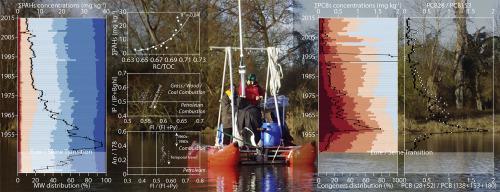当前位置:
X-MOL 学术
›
Appl. Geochem.
›
论文详情
Our official English website, www.x-mol.net, welcomes your feedback! (Note: you will need to create a separate account there.)
Temporal trends, sources, and relationships between sediment characteristics and polycyclic aromatic hydrocarbons (PAHs) and polychlorinated biphenyls (PCBs) in sediment cores from the major Seine estuary tributary, France
Applied Geochemistry ( IF 3.4 ) Pub Date : 2020-11-01 , DOI: 10.1016/j.apgeochem.2020.104749 Thomas Gardes , Florence Portet-Koltalo , Maxime Debret , Kevin Humbert , Romain Levaillant , Michel Simon , Yoann Copard
Applied Geochemistry ( IF 3.4 ) Pub Date : 2020-11-01 , DOI: 10.1016/j.apgeochem.2020.104749 Thomas Gardes , Florence Portet-Koltalo , Maxime Debret , Kevin Humbert , Romain Levaillant , Michel Simon , Yoann Copard

|
Abstract Temporal trends in polycyclic aromatic hydrocarbons (PAHs) and polychlorinated biphenyls (PCBs) were reconstructed from sediment cores collected in the Martot and Les Damps ponds, downstream of the Eure River watershed. PAHs exhibited a positive correlation with fine fractions, but mainly with the refractory organic carbon measured in the sediments, which suggests PAH inputs from materials largely composed of refractory carbon (e.g. soot). Since around the 1940s, PAH concentrations ranged between 2.93–38.20 and 2.27–28.20 mg kg−1 in sediment cores from the Martot and Les Damps ponds, respectively. Based on the temporal distribution of isomers and diagnostic ratios, the PAHs in the sediments were found to be predominantly of pyrogenic origin, particularly in the 1940s–1960s, when PAH levels were particularly high. PCBs also showed an affinity with the fine fraction and with refractory organic carbon, albeit less so than PAHs. Since around the 1940s, PCB concentrations ranged between 0.02–1.57 in Martot Pond and 0.09–1.60 mg kg−1 in Les Damps Pond. The recorded PCB temporal trends were mainly associated with the production, consumption, and banning of these chemicals in France. According to the temporal distribution of PCB congeners, high levels in the 1950s–1970s were linked to “technical mixture” discharges into waterways, which were mainly composed of “low chlorinated congeners”, whereas PCB levels after the 1970s were of atmospheric origin.
中文翻译:

法国塞纳河主要支流沉积岩芯中沉积物特征与多环芳烃 (PAH) 和多氯联苯 (PCB) 的时间趋势、来源和关系
摘要 多环芳烃 (PAH) 和多氯联苯 (PCB) 的时间趋势是从 Eure 河流域下游的 Martot 和 Les Damps 池塘收集的沉积物核心重建的。PAH 与细颗粒呈正相关,但主要与沉积物中测量的难熔有机碳呈正相关,这表明 PAH 输入主要来自主要由难熔碳(例如烟灰)组成的材料。自 1940 年代左右以来,来自 Martot 和 Les Damps 池塘的沉积物核心中的 PAH 浓度分别介于 2.93-38.20 和 2.27-28.20 mg kg-1 之间。根据异构体的时间分布和诊断比率,发现沉积物中的多环芳烃主要来源于热解,特别是在 1940 年代至 1960 年代,当时多环芳烃含量特别高。PCB 还显示出与细小部分和难熔有机碳的亲和力,尽管不如 PAH。自 1940 年代左右以来,Martot Pond 的 PCB 浓度介于 0.02–1.57 和 Les Damps Pond 的 0.09–1.60 mg kg-1 之间。记录的 PCB 时间趋势主要与法国这些化学品的生产、消费和禁用有关。根据 PCB 同系物的时间分布,1950 年代至 1970 年代的高水平与排放到水道的“技术混合物”有关,主要由“低氯化同系物”组成,而 1970 年代之后的 PCB 水平来自大气。记录的 PCB 时间趋势主要与法国这些化学品的生产、消费和禁用有关。根据 PCB 同系物的时间分布,1950 年代至 1970 年代的高水平与排放到水道的“技术混合物”有关,主要由“低氯化同系物”组成,而 1970 年代之后的 PCB 水平来自大气。记录的 PCB 时间趋势主要与法国这些化学品的生产、消费和禁用有关。根据 PCB 同系物的时间分布,1950 年代至 1970 年代的高水平与排放到水道的“技术混合物”有关,主要由“低氯化同系物”组成,而 1970 年代之后的 PCB 水平来自大气。
更新日期:2020-11-01
中文翻译:

法国塞纳河主要支流沉积岩芯中沉积物特征与多环芳烃 (PAH) 和多氯联苯 (PCB) 的时间趋势、来源和关系
摘要 多环芳烃 (PAH) 和多氯联苯 (PCB) 的时间趋势是从 Eure 河流域下游的 Martot 和 Les Damps 池塘收集的沉积物核心重建的。PAH 与细颗粒呈正相关,但主要与沉积物中测量的难熔有机碳呈正相关,这表明 PAH 输入主要来自主要由难熔碳(例如烟灰)组成的材料。自 1940 年代左右以来,来自 Martot 和 Les Damps 池塘的沉积物核心中的 PAH 浓度分别介于 2.93-38.20 和 2.27-28.20 mg kg-1 之间。根据异构体的时间分布和诊断比率,发现沉积物中的多环芳烃主要来源于热解,特别是在 1940 年代至 1960 年代,当时多环芳烃含量特别高。PCB 还显示出与细小部分和难熔有机碳的亲和力,尽管不如 PAH。自 1940 年代左右以来,Martot Pond 的 PCB 浓度介于 0.02–1.57 和 Les Damps Pond 的 0.09–1.60 mg kg-1 之间。记录的 PCB 时间趋势主要与法国这些化学品的生产、消费和禁用有关。根据 PCB 同系物的时间分布,1950 年代至 1970 年代的高水平与排放到水道的“技术混合物”有关,主要由“低氯化同系物”组成,而 1970 年代之后的 PCB 水平来自大气。记录的 PCB 时间趋势主要与法国这些化学品的生产、消费和禁用有关。根据 PCB 同系物的时间分布,1950 年代至 1970 年代的高水平与排放到水道的“技术混合物”有关,主要由“低氯化同系物”组成,而 1970 年代之后的 PCB 水平来自大气。记录的 PCB 时间趋势主要与法国这些化学品的生产、消费和禁用有关。根据 PCB 同系物的时间分布,1950 年代至 1970 年代的高水平与排放到水道的“技术混合物”有关,主要由“低氯化同系物”组成,而 1970 年代之后的 PCB 水平来自大气。


























 京公网安备 11010802027423号
京公网安备 11010802027423号